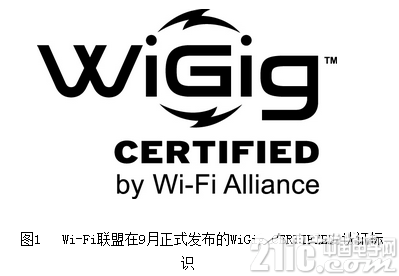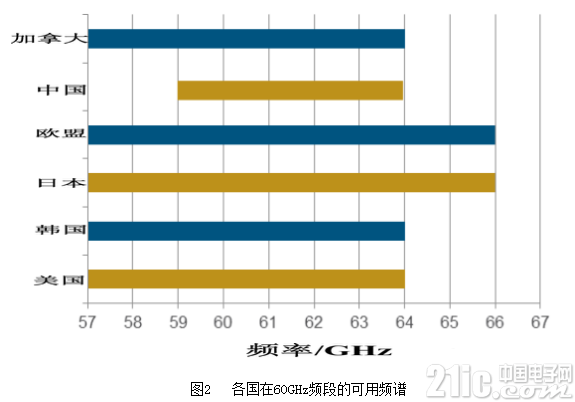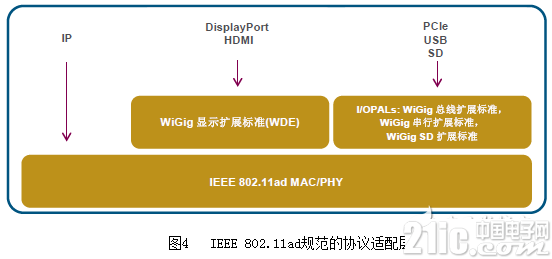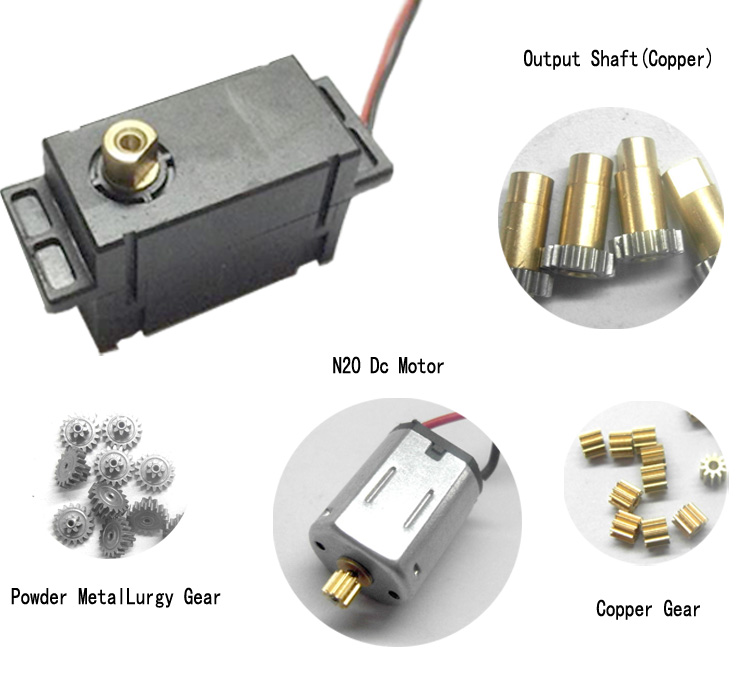Wi-Fi routers have become a must-have device in every home in recent years, but not everyone knows about them every day, they are a way to allow electronic devices to connect to a wireless local area network (WLAN). The technology usually uses the 2.4G UHF or 5G SHF ISM RF band. Connecting to a wireless LAN is usually password protected; but it can also be open, allowing any device within the WLAN range to be connected. This article refers to the address: http:// Wi-Fi is a brand of wireless network communication technology and is owned by the Wi-Fi Alliance. The goal is to improve interoperability between wireless network products based on the IEEE 802.11 standard. Some people use the LAN that uses the IEEE 802.11 family of protocols as wireless fidelity. Even Wi-Fi is equated with wireless internet (Wi-Fi is an important part of WLAN). This article introduces IEEE 802.11ad (60 GHz Wi-Fi) technology. In 2013, the Wi-Fi Alliance officially released the WiGig CERTIFIED certification mark (as shown in Figure 1) and announced that the related products will enter the market next year, and announced that it will pass. Industry collaboration to drive the development of 60 GHz technology. After studying the WiGig (60GHz Wi-Fi) related technical specifications in detail, I feel that WiGig/IEEE 802.11ad devices have high capacity and high rate in multimedia applications compared to current Wi-Fi (PHY adoption) OFDM solution with a maximum transmission rate of 7 Gbps and a single carrier modulation scheme with a maximum transmission rate of 4.6 Gbps), low latency, and low power consumption (because: 1 Wi-Fi Alliance requires all WiGig CERTIFIED products to support single carrier modulation) Solution; 2 IEEE 802.11ad MAC can perform power management in real time according to the actual traffic load of the device; 3 protocol adaptation (currently defines A/V protocol adaptation and I/O protocol adaptation) directly on the PHY and MAC Operation to minimize power consumption), low complexity in chip design and manufacturing (single-carrier modulation and multi-carrier modulation share preamble and channel coding, etc.), higher security (using AES encryption, and hardware implementation It has a better user experience (the PHY supports multi-band switching and operation, MAC supports 11n, 11ac MAC and management MAC) and other outstanding advantages. The following is a detailed introduction of WiGig/IEEE 802.11ad: 1. Introduction to WiGig and its relationship with IEEE 802.11ad (60 GHz Wi-Fi) The widespread adoption and use of digital multimedia content has led to continuous innovation in wireless connectivity technologies. The market's demand for high-rate, high-capacity, low-latency transmissions is driving the development of new technologies that complement traditional Wi-Fi capabilities—a new technology, WiGig, that uses the 60 GHz band for transmissions of up to 7 Gbps Rate to support a variety of advanced applications. The WiGig technology based on the IEEE 802.11ad standard was originally developed by WiGig (Wireless Gigabit Alliance). The IEEE 802.11ad standard is a revision of the 802.11 standard that supports multiple gigabit wireless communications over the 60 GHz band. The WiGig MAC/PHY specification was handed over to the IEEE 802.11ad standardization task group by WiGig in 2010 and was confirmed as the basis for the draft 802.11ad standard in May 2010. At the end of 2012, 802.11ad received IEEE approval. In 2013, the WiGig Alliance merged with the Wi-Fi Alliance to strengthen all of the technology and certification development efforts within the Wi-Fi Alliance, resulting in tightly coordinated connectivity and application layer solutions. Currently, members of the Wi-Fi Alliance have developed the WiGig CERTIFIED certification program for product interoperability verification. The program is expected to begin product interoperability testing in 2014, and certified products will carry the WiGig CERTIFIED certification mark and associated logo. The Wi-Fi Alliance said: "WiGig technology complements Wi-Fi technology to extend to new applications and more seamlessly integrate Wi-Fi Alliance products without wires or cables. Work hard with the vision." 2. Technical characteristics of IEEE 802.11ad (60 GHz Wi-Fi) WiGig technology uses the 60 GHz band, and more spectrum is available in the 60 GHz band than in the 2.4 GHz and 5 GHz bands, enabling faster transmissions up to 7 Gbps by using a wider channel with a low power modulation scheme. The data transfer rate makes it ideal for indoor connections to support demanding multimedia applications including video. Key features of the WiGig/IEEE 802.11ad specification include: maximizing performance; minimizing implementation complexity and cost; coordinating with existing Wi-Fi technology; providing advanced security. These main features include: 1) Support data transfer rates of up to 7 Gbps; 2) Unique design supports low-power handheld devices such as mobile phones and high-performance devices such as computers, and advanced power management technology; 3) The device can be transparently switched between 802.11 networks operating in any frequency band (including 2.4 GHz, 5 GHz and 60 GHz); 4) Support beamforming to maximize signal strength and achieve good communication at distances up to 10 meters away; 5) Use the Galois/Counter Mode in the AES encryption algorithm for security protection; 6) High-performance wireless implementation supporting HDMI, DisplayPort, USB and PCIe. 3. Physical layer of IEEE 802.11ad (60 GHz Wi-Fi) 1) Spectrum and channel The 60 GHz band does not require authorization and is widely used. As shown in Figure 2, the spectrum available in different countries varies in the 60 GHz band: The spectrum resources in the 60 GHz band are much richer than the 2.4 GHz and 5 GHz bands – typically 7-8 GHz bandwidth. The 60 GHz band is also divided into multiple channels - the 802.11ad specification defines four channels, each with a channel width of 2.16 GHz. 2) Modulation and coding The IEEE 802.11ad specification supports two types of modulation and coding schemes: 1) OFDM. The maximum transmission speed allowed is up to 7 Gbps; 2) Single carrier. Low power consumption makes it ideal for small, low-power handheld devices. The single carrier scheme supports transmission speeds up to 4.6 Gbps. These two modulation schemes have some common elements (such as preamble and channel coding, etc.), which reduces the complexity of the implementation. It is reported that in the future, all WiGig CERTIFIED devices must support single-carrier modulation, and some devices must also support OFDM. 4. MAC layer of IEEE 802.11ad (60 GHz Wi-Fi) The new features of the IEEE 802.11ad specification's MAC layer support advanced usage models, facilitate integration with Wi-Fi networks, reduce power consumption, and provide strong security. 1) MAC architecture As shown in Figure 3, the IEEE 802.11ad specification defines a new MAC architecture that enables two devices to communicate directly with each other, thereby developing new features (such as fast synchronization of two devices, and to a projector or television). Send audio and video data, etc.). In addition, the IEEE 802.11ad specification also supports the current 802.11 network architecture. 2) User experience improvement technology As can be seen from Figure 2, the IEEE 802.11ad MAC achieves a seamless fallback to 2.4 GHz or 5 GHz Wi-Fi if the 60 GHz band connection is not available, which can greatly enhance the user experience (for example, in the device from With 60 GHz switching to lower frequency Wi-Fi channels, users using Wi-Fi/WiGig integrated devices will continue to enjoy uninterrupted connectivity. Users will not only experience high performance, but will also be able to automatically utilize 60 GHz. The extra rate brought by the frequency band). 3) Power management technology WiGig CERTIFIED devices will be able to reduce power consumption with a new predetermined access mode: two devices communicating with each other through directional connections can schedule a period of time during which they communicate, during which time the device begins to sleep. This advanced feature allows the device to perform power management more accurately based on actual traffic load - this is especially important for mobile phones and other handheld battery-powered devices. 4) Security technology The IEEE 802.11ad specification builds on the strong security mechanisms defined by the IEEE 802.11 standard. The encryption capabilities of WiGig CERTIFIED devices are based on the government-level advanced encryption standard AES and can be implemented in hardware for high performance and efficiency. 5. Protocol Adaptation Layer (PAL) for IEEE 802.11ad (60 GHz Wi-Fi) As shown in Figure 4, the Protocol Adaptation Layer (PAL) of the IEEE 802.11ad specification allows for the implementation of some standard interfaces that run directly on the MAC and PHY layers in a wireless manner: 1) Audio/Video: WiGig Display Extension (WDE) WDE supports wireless transmission of audiovisual data (such as transferring movies from a computer or digital camera to a television or projector). This PAL supports HDMI and DisplayPort interfaces as well as wireless implementations of high bandwidth digital content protection (HDCP) solutions for protecting digital content transmitted over these interfaces. Its scalability allows it to transmit both compressed and uncompressed video. 2) Input/output PAL: WiGig bus extension, WiGig SD extension, and WiGig serial extension The input/output PAL defines a high performance wireless implementation of a computer interface that is widely used in the 60 GHz band. There are three types of currently defined I/O protocols (PAL): WiGig Bus Extension (PCIe), WiGig SD Extension (Secure Digital I/O), and WiGig Serial Extension (USB). (1) WiGig bus expansion Inside the computer, PCIe is typically used to connect the CPU and memory to an I/O controller that supports storage, network cards, and other interfaces. In addition, it can be used to connect to media and visual processors to improve image quality or offload CPU processing. The implementation of PAL supports multi-gigabit wireless synchronization between devices, as well as connections to storage and other high-speed peripherals. (2) WiGig SD extension SD memory cards are widely used in mobile devices to store various files such as documents, pictures, and audio and video content. The WiGig SD extension is used to access an SD memory card installed on a remote device from a host device, such as an SD memory card on a smartphone from a laptop. The WiGig SD expansion is suitable for battery-powered devices with limited resources because it optimizes the implementation process for easy storage access, and file transfer speeds can reach billions of bits, while significantly saving energy. (3) WiGig serial extension USB is often used to connect peripherals and other devices to the host. This USB PAL supports wireless connectivity between USB devices and facilitates the development of products such as USB extensions. The WiGig serial extension has been handed over from the Wi-Fi Alliance to the USB-IF for use as the basis for the medium-free serial bus specification.
Electronic Lock Motor product introduction:
Electronic Lock Motor, also known as Intelligent lock motor, Belong to small reducer series, the main structure composed of drive motor (motor) with a reduction gear box, composed of a shaft connection, form integrated motor reducer; Drive motor is purchasing product, reduction gear box is customized according to the project product demand, the maximum power under 10 w, maximum voltage up to 12 v, below 25 mm diameter size.
Functions: it is widely used in various intelligent locks, such as Shared bicycle lock, fingerprint lock, glass lock, safe lock, hotel lock, family lock, inductive smart lock, etc
Features:China Electronic Lock Motor is based on micro precision reducer development, small intelligent micro precision reducer can do 10 mm in diameter, is widely used in safe, locks, smart locks, sensor intelligent lock;
This kind of motor has the characteristics of low noise, low energy consumption, small volume, light quality, high precision, large torque and durability
Method of use: the best stable in horizontal plane, installed on the China Electronic Lock Motor output shaft parts, cannot use a hammer to knock, knock prone to press into the dc Electronic Lock Motor drive, may cause damage to internal components, and cannot be used in the case of blocked.
Operating temperature range:
Electronic Lock Motor should be used at a temperature of -10~60℃.
The figures stated in the catalog specifications are based on use at ordinary room temperature catalog specifications re based on use at ordinary room temperature (approximately20~25℃.
If a electronic Lock Motor is used outside the prescribed temperature range,the grease on the gearhead area will become unable to function normally and the motor will become unable to start.Depending on the temperature conditions ,it may be possible to deal with them by changing the grease of the motor's parts.Please feel free to consult with us about this.
Storage temperature range:
China Electronic Lock Motor should be stored ta a temperature of -15~65℃.
In case of storage outside this range,the grease on the gearhead area will become unable to function normally and the motor will become unable to start.
Service life:
â—Use with a load that exceeds the rated torque
â—Frequent starting
â—Momentary reversals of turning direction
â—Impact loads
â—Long-term continuous operation
â—Forced turning using the output shaft
â—Use in which the permitted overhang load or the permitted thrust load is exceeded
â—A pulse drive ,e.g.,a short break,counter electromotive force,PWM control
â—Use of a voltage that is nonstandard as regards the rated voltage
â—Use outside the prescribed temperature or relative-humidity range,or in a special environment.
â—Please consult with us about these or any other conditions of use that may apply,so that we can be sure that you select the most appropriate model.
when it come to volume production,we're a major player as well .each month,we rurn out 600000 units,all of which are compliant with the rohs directive.Have any questions or special needed, please contact us, we have the engineer group and best sales department to service to you
Looking forward to your inquiry. Welcome to our factory.
Electronic Lock Motor,Motor For Electronic Lock,Electronic Lock Dc Motor,Electronic Lock High Speed Motor Shenzhen Shunchang Motor Co., LTD. , https://www.scgearmotor.com




